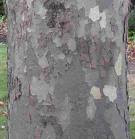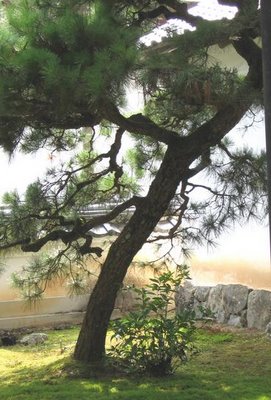::::::::::::::::::::::::::::::::::::::::::::::::::::::::::::::::::::::::::::::::::::::::::::::::::::
Autumn dusk (aki no kure)
***** Location: Japan, worldwide
***** Season: All Autumn
***** Category: Season
*****************************
Explanation
© PHOTO Gabi Greve, October 2007
autumn dusk, autumn twilight,
aki no kure 秋の暮 (あきのくれ)
autumn nightfall, autumn evening, autumn eve
"aki no kure" might also refer to the end of autumn.
SEE
Autumn coming to an end
But this is usually expressed in the opposite wording
kure no aki, the twilight of autumn itself, 暮の秋(くれのあき)
evening dusk in autumn, aki no yuugure
秋の夕暮(あきのゆうぐれ)
..... aki no yuube 、秋の夕(あきのゆうべ)
autumn evening, shuuseki 秋夕(しゅうせき)
:::::::::::::::::::::::::::::::::::::::::::::::::::::::::::::::::::::::::::::::::::::::::::::::::::::
"Autumn means sunset (dusk)" (aki wa yuugure)
is a famous statement in the Pillow Book of Sei Shonagon (Sei Shoonagon 清少納言, Makura Sooshi 枕草子). It has long been loved by Japanese poets and together with the SPRING DAWN (haru no akebono) been the subject of many poems.
In autumn, it is still warm enough to be outside and enjoy the passing of the time, watch the valley change from light to shadow, the colors of the sky and the soft clouds constantly changing.
In the times of Basho this kigo was used to express feelings of "the sadness of things" (mono no aware) and solitude or melancholy (sabishisa).
Twilight, dusk ... and many related kigo
*****************************
Worldwide use
*****************************
Things found on the way
Miyamoto Musashi (宮本 武蔵) (c.1584 - 1645)
*****************************
HAIKU

Miyamoto Musashi
枯木鳴鵙図 宮本武蔵筆
Matsuo Basho and his famous haiku in translations
枯朶に烏のとまりけり秋の暮
枯れ枝に鴉のとまりけり 秋の暮
(かれえだにからすのとまりけりあきのくれ)
kara eda ni karasu no tomari keri aki no kure
A crow
has settled on a bare branch
Autumn evening
On a withered branch,
A crow has stopped
Autumn's eve
A lone crow
sits on a dead branch
this autumn eve
Read more about Basho and some Crow Haiku.
http://www.shades-of-night.com/aviary/haiku.html
..................... More translations:
On a withered branch
a crow is perched:
an autumn evening.
... bopsecrets
a crow is perched on a bare branch;
it is an autumn eve.
Classic Haiku: An Anthology of Poems by Basho and His Followers
On dead branches
Crows remain perched
At autumn's end.
... www.tapsns.com
On a dead limb
squats a crow.
Autumn night.
... www.cs.arizona.edu
on a bare branch
a crow perches
in the autumn twilight
... http://www.ecf.or.jp/shiki/1999/dec5.html
................. One more interpretation
First Basho realized that it was an autumn evening. Then he saw the crow on a bare branch.
The order of events is not:
First he saw a crow on a branch, then he remembered it was autumn.
a crow is perched
on a barren branch -
this autumn evening
Tr. Gabi Greve
:::::::::::::::::::::::::::::::::::::::::::::::::::::::::::::::::::::::::::::::::::::
"Expressing how I feel"
この道や行く人なしに秋の暮れ
kono michi ya yuku hito nashi ni aki no kure
on this road
where nobody else travels
autumn nightfall
and an earlier version
The road here--
No traveler comes along
This autumn evening.
Matsuo Basho . Tr. Makoto Ueda
. . . . More translations
Along this road
Goes no one;
This autumn evening.
An autumn eve;
Along this road
Goes no-one.
No-one
Walks this road;
Autumn evening.
Along this autumn road
Goes no-one,
This autumn eve.
R.H. Blyth
By lonely roads
this lonely poet marches
into autumn dusk.
Beilenson
this road--
with no one on it,
autumn dusk
Barnhill
This road--
no one goes down it,
autumn evening.
Robert Hass
This road:
with no one traveling on it,
autumn darkness falls.
Harold Henderson
None is traveling
Here along this way but I,
This autumn evening.
Kenneth Yasuda
This road ––
no one goes down
autumns end.
Tr. Peipei Qiu
All along this road
not a single soul—only
autumn evening
[The Essential Basho,
Sam Hamill, Boston: Shambhala, 1998]
Not one traveller
braves this road -
autumn night.
Stryck
on this road
no one is seen to travel...
autumn's end
Susumu Takiguchi : "Go-Schichi-Go"
Along this way
No travellers -
Dusk in autumn
Alex Kerr - "Lost Japan" - 1996
This road
No travelers pass along--
Autumn dusk.
T.Saito, W.R.Nelson - "1020 Haiku in Translation" -2006
.........................................
Haruo Shirane:
"Traces of Dreams" - Stanford University Press, 1998
"In the late autumn of 1694 (...), at the end of his life, Basho wrote the following hokku, which appears in Backpack Diary (Oi nikki; 1695).
this road--
no one goes down it
autumn's end
kono / michi / ya / yuku / hito / nashi / ni / aki / no / kure
this / road / : /go / person / none / as / autumn / 's / end
This hokku, which was composed at a large haikai gathering, can be read as a straightforward description of the scene before the poet, as an expression of disappointment that, at the end of his life, in the autumn of his career - "aki no kure" can mean either "autumn's end" or "autumn evening" - he is alone, or that life is lonely, and as an expression of disappointment at the lack of sympathetic poetic partners (renju), that is, as an expression of desire for those who can engage in the poetic dialogue necessary to continue on this difficult journey.
Significantly, on Basho's last journey in the summer of 1694, from Edo to Iga, he deliberately stopped at Nagoya, to try to heal the breach with his former poetry companions, those surrounding Kakei, and then he departed for Osaka, where he would die, in attempt to mediate a territorial dispute between two disciples, Shado and Shido."
.........................................
. . . . Look at a painting HERE
MICHI, Road, by Higashiyama Kaii

Special Thanks to Larry Bole for bringing
Higashiyama Kaii and Basho together!
MORE - hokku about aki no kure by
. Matsuo Basho 松尾芭蕉 - Archives of the WKD .
:::::::::::::::::::::::::::::::::::::::::::::::::::::::::::::::::::::::::::::::::::::::::::::::::::::
. WKD : Kobayashi Issa 小林一茶 .
一つなくは親なし鳥よ秋の暮
hitotsu naku wa oya nashi tori yo aki no kure
alone he cries
the motherless bird...
autumn dusk
我植し松も老けり秋の暮
waga ueshi matsu mo oi keri aki no kure
even the pine tree
I planted grows old!
autumn dusk
又人にかけ抜れけり秋の暮
mata hito ni kakenukare keri aki no kure
yet another traveler
overtakes me...
autumn dusk
Read many more here:
Tr. David Lanoue
.............................................................................
朝顔の生れ替りや秋の暮
asagao no umare-kawari ya aki no kure
autumn twilight --
morning glories
reborn
Tr. Chris Drake
This mid-autumn hokku is from the 8th month (Sept.) of 1814, when Issa was on a trip to Edo, his first trip back after establishing himself in his hometown. His main purpose was to formally say goodbye to poet friends and students there. The hokku was probably written on 8/9 (Sept. 22), since in Issa's diary it occurs only two hokku after his bittersweet hokku about returning to the city where he painfully grew to maturity:
江戸へエドへ出れば秋の暮
Edo! Edo!
when I'm here it's just edo --
autumn twilight
Tr. Chris Drake
Though the city brings back many memories of suffering, the sky probably seems larger in Edo than in Issa's hometown, since there are no high mountains to block the sky on the horizon, and Issa seems to have been very moved by the sky on his first evening back in the city. In the Edo/Tokyo area, morning glories usually bloom until around the end of October, a month after this hokku was written, so there are no doubt many morning glories still in bloom.
By "rebirth" Issa must be referring to the daily rhythm of morning glories, which close or "die" for the day by around noon. At day's end, however, the shriveled morning glories seem to be reborn in the clear autumn sky, which opens gradually, as if it were a great flower, turning to very deep blue, then blue-purple, and then violet -- all common morning glory colors.
The image of the early evening sky becoming a great, reborn morning glory suggests that Issa himself feels a kind of rebirth going on in his relationships with people in and around Edo, many of which he wants to revive and keep alive even after moving to his hometown. If the hokku is taken as overtly self-referential and symbolic, perhaps Issa is also suggesting that the early morning-glory part of his life is gone forever but that now, at fifty-two and approaching the twilight of his life, he feels he will be reborn with a new, more autobiographical kind of blooming or style of haikai as he moves back and forth between country and city.
Chris Drake
なかなかに人と生れて秋の暮
naka-naka ni hito to umarete aki no kure
born human,
I'm able to feel it --
autumn twilight
This hokku is from the 1811 Waga haru-shū or My Year's Collection hokku anthology. It also appears in six other collections. The slightly elliptical hokku begins with a suggestive expression used in classical waka and also in a famous hokku by Buson that he might be alluding to:
because I'm alone
I'm able to make friends
with the moon
nakanaka ni hitori areba zo tsuki o tomo
You might think that being alone on the night of a full moon is not desirable, Buson suggests, but it's precisely because I'm alone that I've been able to become intimate with the moon. While stressing the value of aloneness, Buson also admits that he is human and often feels loneliness. In Issa's hokku the image is even more wide-ranging. He seems to be referring to himself, but in Japanese the hokku can also refer to all humans. Speaking only of Issa, however, the hokku suggests that if he had not been born as a human the autumn twilight surrounding him would be quite different, since it would not have any overall meaning beyond immediate physical sensations. Because he is human, the autumn dusk enables him to deeply feel the fragility of all beauty and relationships, for example, and the pathos of all things as they pass away as well as the nostalgia that their disappearance occasions.
I think Issa, like Buson, is also referring to the other side of what he experiences: sometimes autumn twilight makes him feel simply lonely and discouraged after a day of struggling to make ends meet or failing get a decent meal. If he were a bird or a ground animal, he could just continue on, following his instincts, and not worry in detail about the future or about various relationships, but he does worry, and worry teaches him things. Issa is glad he was born a human, and he seems to affirm that for him autumn twilights may sometimes be disheartening, but all are vitally important and help him learn what it means to be a human person.
Chris Drake
:::::::::::::::::::::::::::::::::::::::::::::::::::::::::::::::::::::::::::::::::::::::::::::::::::::
autumn dusk
the sound of rooks gathering
in an old oak
© Morden Haiku
:::::::::::::::::::::::::::::::::::::::::::::::::::::::::::::::::::::::::::::::::::::::::::::::::::::
autumn dusk
only a crow outside
my window
© Deborah P Kolodji / Falling Leaves 2006
*****************************
Related words
***** Autumn (aki) and related KIGO
autumn night
***** Seasons coming to an end
***** Loneliness (sabishisa)
***** . Autumn Melancholy
© PHOTO Gabi Greve, Autumn 2006
:::::::::::::::::::::::::::::::::::::::::::::::::::::::::::::::::::::::::::::::::::::::::::::::::::
































